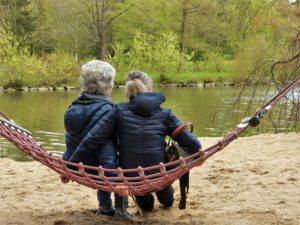Cultural Humility
 Meeting people where they are, even when we’re not sure where that is
Meeting people where they are, even when we’re not sure where that is
When we think about going to the doctor, we often think about it as a simple process: make an appointment, find out what the problem is, treat it, and then OK! we’re good until the next bump in the road. But those of us who have dealt with, or are dealing with, a serious illness know that it’s not nearly so simple. I often say, when teaching about subjects related to illness, “the world is divided into two groups of people: those who don’t get it (yet), or ‘yep, been there… we get it. Got a PhD in that now.’” This could involve something like going to the specialist for the first time after learning you have a serious illness, dealing with the death of a parent, or experiencing a sudden loss, or supporting a friend in one of those situations. For the most part, we aren’t taught how to navigate these waters. We have to figure it out ourselves.
Often, the bumps in the road we run across look different for each of us. Our journey is different because we bring our own unique life experiences to the examining room table. Even once we bridge this gap of “don’t get it” to “get it,” we still have a situation where we live in a society composed of people who live in a variety of different cultural contexts: different races, religions, skin colors, family traditions, sexual orientations.
“At Transitions LifeCare, we not only provide care to people from an amazing and wonderful variety of cultures, but we also ARE those people – our staff members come from diverse backgrounds and life situations.”
So how do we provide the best care possible when we have such different perspectives? That is where the idea of cultural humility comes into play. Kimberly Curseen, MD says that “Cultural humility is the ability to meet with another person, and despite all the things you have heard, still be open to hearing their story.”1 Sounds easy, right? Just listen!! Welllll… not so fast. Think about the last time you truly listened to someone – really listened. Without having an agenda. Without trying to offer a solution. Without judging. Without bringing in any assumptions or opinions based on your past experiences. Without trying to categorize, name, or label them. Hmmm… might be a little harder than it sounds, yes?
If we as providers approach our clients with an approach of cultural humility, we are learners too. We are on a journey alongside our patients, clients, and their families to support them to discover what they already know; to learn from them – who are, after all, the experts on themselves. This does not mean we don’t offer our expertise, but we do it within a partnership.
Vivian Chavez suggests to us that embracing cultural humility involves three key principles2:
1. Lifelong learning and critical reflection
2. Recognize and challenge power imbalances
3. Institutional accountability
Let’s put those principles into the real world here. When we really use her framework of cultural humility, it goes beyond the exam room and out into the world, our larger playing field. And we need the whole field!
First, we start with ourselves. We find ways to learn more and to reflect on our lives, the assumptions we were raised with, what we see around us. Who feels like they can ask the doctor questions, and who doesn’t? Who knows about hospice and palliative care programs, and who doesn’t? Or who thinks those services “aren’t for me,” and why? We look under the rocks and become curious.
Once we have been doing this for a while, we may begin to see where power and privilege come into play. We may begin to understand that when Person A says such-and-such to Person B, it’s not just about those two people, or that set of words, but we have to step back and put that interaction into context.
And finally, we need to hold our institutions accountable. We find out how to make our agency, or hospital, or library a place that welcomes all people. We suggest to our Rotary Club that we look at our membership. And we just get started. It doesn’t have to be perfect (it won’t be anyway – nothing is!). We start where we are and continue to move forward. Maybe we advocate for our staff to receive training about microaggressions – those seemingly innocuous comments that end up being discriminatory. Or training on how best to serve LGBTQ patients and families. Or we plan a lunchtime Zoom, watch a video clip together, and talk about it.
And then, when we are in that exam room, our actions have so much more “oomph” because they take place within a whole context of cultural humility. It’s from a place of real listening, not because “that’s what we’re supposed to say/do now.” Our actions aren’t just individual actions but are backed up by our institution’s policies, too.
Betsy Barton, educator at Transitions LifeCare, has learned a lot from her experiences in advocating for family members and loved ones who faced serious illness. Educating clinicians about cultural humility is one of her strongest interests.
1 Curseen K. 1Curseen:”Implicit Bias and Its Impact in Geriatrics, Hospice and Palliative Care,” GeriPal October 27, 2017: https://www.geripal.org/2017/10/implicit-bias-and-its-impact-in-geriatrics-palliative-care.html
2 Chavez V. Cultural Humility. https://www.youtube.com/watch?v=SaSHLbS1V4w 2020.